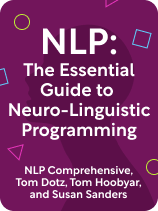

This article is an excerpt from the Shortform book guide to "NLP: The Essential Guide to Neuro-Linguistic Programming" by Tom Hoobyar, Tom Dotz, and Susan Sanders. Shortform has the world's best summaries and analyses of books you should be reading.
Like this article? Sign up for a free trial here.
What happens in your mind when you think about something? What if you could harness your thoughts to create positive changes in your life?
Neuro-Linguistic Programming (NLP) explores the fascinating connection between your thoughts, feelings, and behaviors. Through understanding how your brain processes information and creates sensory experiences, you can learn to consciously shape your mental patterns for better outcomes.
Keep reading for an overview of NLP: The Essential Guide to Neuro-Linguistic Programming by Tom Hoobyar, Tom Dotz, and Susan Sanders.
Overview of NLP: The Essential Guide to Neuro-Linguistic Programming
Your thoughts play a crucial role in shaping your experiences: They influence how you perceive, interpret, and respond to your environment. It follows then, that if you want to change something in your life—such as mindset, habits, career, or relationship status—you first need to change your thoughts.
In NLP: The Essential Guide to Neuro-Linguistic Programming, NLP Master Practitioners Tom Hoobyar, Tom Dotz, and Susan Sanders explain what thoughts are, how they influence you, and what specific steps you can take to align them with what you want out of life.
This overview covers the authors’ key ideas in two parts:
- In Part 1, we’ll explain how your thoughts form and impact you. This information will clarify why you tend to think, feel, and behave in certain ways.
- In Part 2, we’ll explore how you can apply this knowledge to change your thoughts—and, subsequently, your feelings and behaviors—to enhance all your experiences.
(Shortform note: According to NLP theory, three processes—neurology, language, and programming—influence all your thoughts, emotions, and behaviors. “Neuro” refers to how you gather data from the world using your five senses. “Linguistic” refers to the way you interpret and make sense of that data. “Programming” refers to the behavioral patterns you learn and develop throughout your life. NLP practitioners suggest that you can harness these three processes to align your thought patterns, emotional responses, and habitual behaviors with your goals. Although some people have anecdotally found benefits from specific NLP practices, some researchers have disputed its efficacy, with some people considering it a pseudoscience.)
Part 1: Understand What Thoughts Are and How They Impact You
Hoobyar, Dotz, and Sanders argue that the only way to change something in your life is to change the way you interpret, feel about, and respond to it. And, to change the way you feel about and respond to it, you need to change the way you think about it.
Though changing thoughts sounds simple, it’s often difficult because thoughts are somewhat intangible and difficult to control. However, the authors explain that this difficulty arises only when you’re not conscious of the processes that underlie your thoughts—that is, where your thoughts come from and why they manifest in the way that they do.
They suggest that understanding these underlying processes is key to making thoughts feel more tangible, and, as a result, easier to change. Therefore, we’ll explore the processes underlying thought formation, covering how:
- Your brain processes data from your environment.
- Your thoughts manifest as sensory impressions.
- Memory associations trigger related sensations.
- Sensory nuances influence all your experiences.
1) Your Brain Processes Data From Your Environment
Beneath your conscious awareness, your brain continually collects, organizes, and stores data to help you understand and interact with your environment—this process defines how you think at any given moment. However, due to the constant influx of complex data, your brain doesn’t record an exact replica of what’s happening in your environment. Instead, it relies on cognitive shortcuts to quickly and efficiently manage this process. This means that your thoughts about your experiences aren’t based on accurate reflections of reality but rather on how your brain has synthesized the data from these experiences.
According to Hoobyar, Dotz, and Sanders, three of the most common cognitive shortcuts include simplifying, filtering, and modifying. Let’s explore how each of these shortcuts impacts how you think about your experiences.
Cognitive Shortcut #1: Simplifying
The authors explain that your brain generalizes the data from your environment by identifying patterns based on your existing knowledge and memories. It does this to reduce the complexity of the external world to manageable, understandable pieces of information.
For example, when encountering a large dog on the street, your brain rapidly sifts through masses of complex data—such as the dog’s breed, size, color, whether it’s on a leash, or if there are other people nearby. Instead of processing each of these details individually, your brain uses your existing memories to quickly simplify the situation. If you were once bitten by a large dog, your brain might simplify this encounter by assessing the dog as a threat.
Cognitive Shortcut #2: Filtering
Your brain decides what it should process and what it should discard based on what’s relevant to your immediate needs, interests, and goals. According to the authors, factors such as your emotional state, physical condition, expectations, and what you’re focusing on at that moment can all influence this decision. For example, because you feel threatened by the dog, your brain focuses on the dog’s size and bark, filtering out other details like its wagging tail.
Cognitive Shortcut #3: Modifying
Hoobyar, Dotz, and Sanders suggest that your brain also modifies the data so that it aligns with your existing knowledge and beliefs, making it easier for you to quickly interpret and understand new experiences. For example, if you once had a bad experience with a dog, your brain might exaggerate the size or aggressiveness of the dog in front of you, altering your perception based on your preconceptions.
2) Your Thoughts Manifest as Sensory Impressions
We’ve just explained that the way your brain processes environmental data influences your thoughts about your experiences. Now, let’s explore how these thoughts manifest—that is, how they express themselves in your mind.
According to Hoobyar, Dotz, and Sanders, all thoughts express themselves through your senses: Thinking about something involves seeing, smelling, hearing, feeling, or tasting it in your mind. Your internal sensory experience is unique to you, shaped by sensory preferences—some people think through a combination of their five senses while others tend to favor one sense over another. For example, when you think about a rainy day, you might feel the sensation of being wet, hear the pitter-patter of raindrops, and visualize gray, cloudy skies. Another person might instead focus on the smell of rain mixed with earth.
3) Memory Networks Trigger Associated Sensations
The authors explain that internal sensations don’t restrict themselves to the specific thing you’re thinking about, but they cascade to include sensations from other experiences.
This phenomenon occurs due to the way your brain categorizes and stores data according to preexisting patterns (Recall: Your brain categorizes data to help you rapidly interpret and understand your environment). In effect, your brain uses your memories to assign meaning to the new data it collects. It then stores that new data alongside those preexisting memories, building networks of associated memories. For example, your brain might store your experience of encountering a seemingly threatening dog in the same memory network that holds your past experience of being bitten by a dog, as well as other experiences that generated the same level of fear.
These memory networks guide the trajectory of your thoughts. The authors explain that, within each network, every memory has the potential to trigger any of the other memories from that network. This explains why your stream of thought seldom follows a direct path, but zigzags from one subject and sensation to another. For example, when thinking about a rainy day, the sensation of being wet might prompt you to recall another experience that involves feeling wet, like swimming. Then, thinking about swimming might evoke the image of a blue swimming pool under a clear sky, which might lead you to think and feel excited about where you’d like to book your next summer vacation, and so on.
4) Sensory Nuances Influence All Your Experiences
We’ve just covered how memory networks guide the trajectory of your thoughts, leading you to flit from one sensation to another. Now, let’s explain how sensory nuances contribute to this process, influencing not only what you think about your experiences but how you feel about and respond to those experiences.
As we’ve established, all thoughts express themselves through your senses. Hoobyar, Dotz, and Sanders suggest that sensory nuances play a critical role in this process. These nuances are the subtle variations in how your senses engage when you think about something.
They explain that sensory nuances can manifest in various ways for each sense:
- Visual: Variations in color, contrast, or size. When thinking about a past event, some details might appear vivid or large while others seem blurry or small.
- Auditory: Variations in volume or clarity. When recalling a conversation, you might hear loud, clear voices in your mind, or the voices might sound muffled and distant.
- Olfactory: Variations in intensity or complexity. When you think about freshly baked bread, you might smell a strong, rich aroma or just a faint whiff that barely registers.
- Tactile: Variations in pressure, temperature, or texture. When thinking about shaking someone’s hand, you might feel a light touch or the warmth of skin.
- Gustatory: Variations in flavor intensity or complexity. Thinking about what you plan to eat for dinner might evoke a strong, mouth-watering taste, or just a hint of flavor.
Sensory Nuances Shape Your Emotional Responses and Behaviors
The authors explain that sensory nuances influence your emotional response to your thoughts, which then influences your subsequent thoughts, feelings, and behaviors. For example, if you vividly imagine the texture and taste of a snack you’re trying to avoid, you’ll likely experience a stronger craving than if you only vaguely recall its flavor—making you more likely to give in to temptation and eat the snack.
Since sensory nuances play a key role in how you think, feel, and respond to your experiences, they determine the types of experiences you move toward or away from. According to the authors, this is because they affect every phase of thinking about an experience:
- Before the experience, when you’re anticipating it: For example, thinking about an upcoming job interview, you visualize crystal-clear images of stern interviewers and hear their critical voices loudly in your mind. These nuances make you feel anxious, leading you to cancel the interview.
- During the experience, when you’re living it: For example, during a conversation, you focus intensely on the other person’s furrowed brow and slightly raised voice. These sensory nuances lead you to interpret their tone as confrontational, causing you to feel defensive and argumentative.
- After the experience, when you’re recollecting it: For example, thinking about a recent vacation, you see the vibrant colors of a sunset and hear the soothing sound of waves. These sensory nuances evoke feelings of relaxation and joy, encouraging you to plan similar trips in the future.
Why It’s Difficult to Change Thoughts, Feelings, and Behaviors
Hoobyar, Dotz, and Sanders explain that, because this sensory-driven thought process typically occurs without your conscious involvement, you notice only the experience and your resulting emotion. This leads you to form unconscious associations between experiences and emotions, and these associations lead you to believe that you have no choice in how you think, feel, and respond to certain situations.
For example, when thinking about an upcoming interview, you don’t realize that the way you’re visualizing stern interviewers makes you feel anxious, which in turn makes you want to cancel your interview. Instead, you believe that job interviews are inherently stressful and intimidating, so you avoid them whenever possible.
Part 2: Take Control of Your Thoughts, Feelings, and Behaviors
We’ve just explained the processes underlying your thoughts, covering where thoughts come from and how sensory nuances influence how you feel about and respond to your experiences. Though these processes typically occur beneath your conscious awareness, Hoobyar, Dotz, and Sanders argue that you can take conscious control of them and choose how to think, feel, and behave—and this will enable you to enhance all your experiences.
The authors offer techniques for aligning your thoughts with three overarching goals:
- Maintain a positive attitude.
- Enhance your self-esteem.
- Achieve success.
Goal #1: Maintain a Positive Attitude
According to the authors, negative sensory nuances such as visualizing potential failures in vivid detail, hearing critical voices with harsh tones, or feeling anxiety-related sensations can make it challenging to maintain a positive attitude. They recommend a two-part process for cultivating a more optimistic mindset: Immerse yourself in positive sensory experiences and distance yourself from negative ones.
1) Immerse Yourself in Positive Sensory Experiences
Practice recalling positive memories as vividly as possible, emphasizing as many sensory nuances as possible—for example, by increasing brightness, size, volume, or intensity. Hoobyar, Dotz, and Sanders explain that this will create a more immersive experience, heightening the positive emotions you feel during recall.
Next, the authors recommend establishing a tactile link to this positive memory by touching your thumb to a specific knuckle while you recall it. According to the authors, this creates a mental association between the action and the positive emotion (the authors refer to this as an “anchor”). You can then repeat the action later to trigger the positive feeling on demand.
2) Distance Yourself From Negative Sensory Experiences
Pay attention to the sensory nuances that precede your negative emotions so that you can identify their underlying causes. For example, you might notice that you visualize yourself looking uncomfortable, hear a harsh inner critic, or feel a knot in your stomach before you begin to feel anxious about public speaking.
Once you’ve identified these nuances, mentally diminish them to reduce their impact on you. For example, decrease the size or brightness of a troubling image, change the tone of a critical voice to a humorous one, or imagine any physical tension you feel being washed away by waves. The authors explain that this creates psychological distance between yourself and the sensory nuances, which lessens their influence on your emotions.
Goal #2: Enhance Your Self-Esteem
Hoobyar, Dotz, and Sanders explain that you’re more likely to suffer from low self-esteem when you vividly recall past failures or embarrassments. To counter this, they recommend diminishing the sensory nuances of these painful memories (as described in Goal #1). Additionally, they suggest a two-step process for focusing attention on your positive traits and for developing new ones:
1) Reflect on what you like about yourself and identify the sensory nuances you focus on when you think about these traits. For example, if you pride yourself on your kindness, you might visualize a bright, colorful image of yourself helping others, or hear a warm, approving inner voice praising your actions.
2) Consider new traits you’d like to adopt and use the same sensory nuances you focus on when you think about your existing positive traits. This will leverage your brain’s positive associations, making it easier to integrate these new traits into your self-image. For example, if you want to be more confident, imagine yourself being confident using the same bright, colorful imagery you associate with your kindness.
Goal #3: Achieve Success
Success means different things to different people—it may involve adopting new habits, communicating more effectively, achieving career goals, or reaching financial milestones. Hoobyar, Dotz, and Sanders suggest that, to achieve success, you first need to be clear about what success means to you.
They explain that a lack of clarity about what you want to achieve creates vague or conflicting sensory representations that prevent you from taking decisive action. And, without a clear target to aim for, you’re more likely to focus on obstacles in your way, creating negative mental associations that hold you back. For example, with a vague goal like “get in shape,” you might hold conflicting images of how you want to look, feel uncertain about which exercises to do, and focus on obstacles like lack of time or energy.
Hoobyar, Dotz, and Sanders suggest three techniques for clarifying and moving toward what you want:
- Set clearly defined goals that align with your values and desires.
- Create vivid, detailed mental images of what you want to achieve.
- Recall previous achievements, linking the sensory details to your current goal.
Technique 1: Set Clearly Defined Goals That Align With Your Values and Desires
The authors explain that setting clear goals that align with your values and desires ensures that achieving them will be genuinely fulfilling, increasing your motivation and commitment. For example, if you value your health and enjoy challenges, you might refine the goal to “get in shape” as follows: Run a 5K race in under 30 minutes within the next six months.
Technique 2: Create Vivid, Detailed Mental Images of What You Want to Achieve
According to Hoobyar, Dotz, and Sanders, engaging all your senses when envisioning your goal makes it feel more tangible and achievable. They suggest paying particular attention to how good you’ll feel once you’ve achieved your goal, as this will help your brain form positive mental associations that make it easier for you to take action toward your goal. For example, you might imagine the sense of accomplishment and joy you’ll feel as you cross the finish line in a 5K race, the sounds of the cheering crowd, and the sight of your time on the clock.
Technique 3: Recall Previous Achievements, Linking the Sensory Details to Your Current Goal
When thinking about your current goal, use the same sensory nuances you focus on when remembering past successes—to achieve this, apply the same method for adopting positive traits (Goal #2). The authors explain that this will encourage your brain to associate the positive sensations from past successes with your current goal, boosting your confidence in your ability to achieve it. For example, recall passing an exam, identifying the feeling of joy when you saw your passing grade, and the sound of your family congratulating you. Then, imagine experiencing these same sensory details—feeling joy and hearing your family cheer you on—as you cross the finish line of your 5K race.

———End of Preview———
Like what you just read? Read the rest of the world's best book summary and analysis of Tom Hoobyar, Tom Dotz, and Susan Sanders's "NLP: The Essential Guide to Neuro-Linguistic Programming" at Shortform.
Here's what you'll find in our full NLP: The Essential Guide to Neuro-Linguistic Programming summary:
- How your thoughts form and impact you
- Why it’s difficult to control your thoughts
- The role senses play in your thoughts






